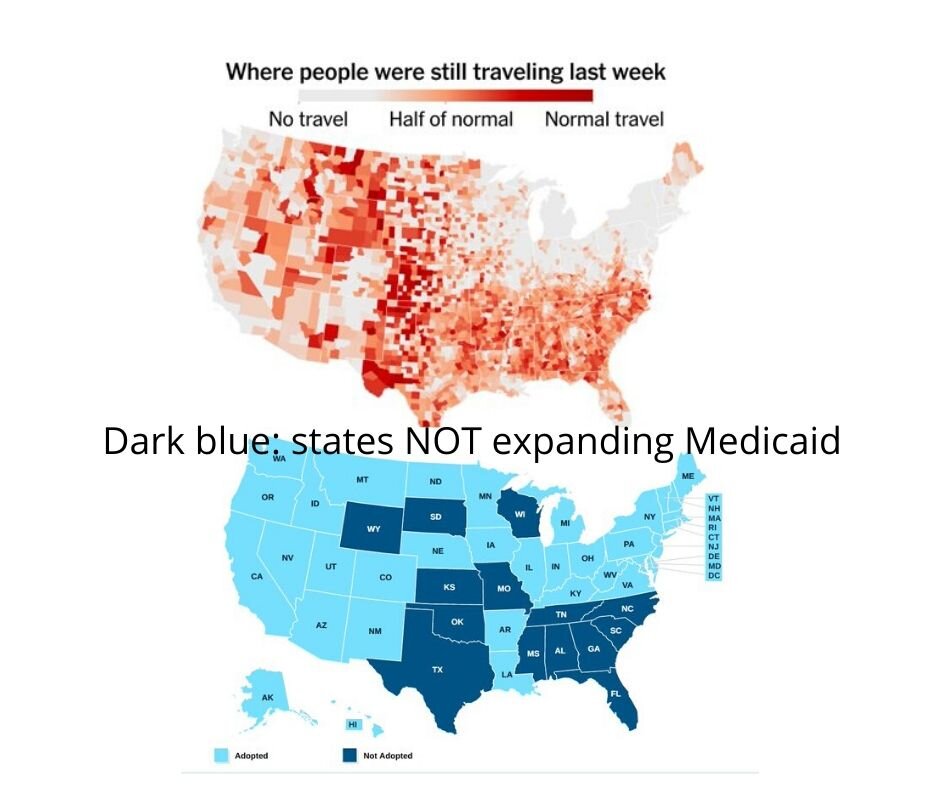The confluence of politics, culture, and disease is unfolding in real time. The overlap of regions following social distancing guidelines and those which are not, with voting trends and support for the Affordable Care Act and Medicaid expansion is striking and will have life and death consequences.
With all the information out there regarding Covid-19 I feel like this platform can be most useful for (1) highlighting under-reported stories and (2) pointing readers to the best resources amidst the crisis. As a reminder to readers who don’t know. I have a MPH and worked in public health in over a dozen countries for nearly 20 years.
In that spirit, here is what I’m watching.
Death Rate: The doubling in the US death rate from 1000 to 2000 in just 24 hours was terrifying for me. Doubling in just 24 hours is a red flag. (For a great video on exponential growth in outbreaks check out this link.) Since then, the rate seems to have “slowed” to doubling roughly 48 to 36 hours. This is still worrisome. The death rates give us some limited data that allows us to extrapolate the prevalence, since mortality is pretty unequivocal and does not require a testing kit. That said, the “hopeful” bit of news here is that mortality rates have a 2 to 5 week lag due to the incubation period of the virus and the time it can take to be fatal. That means patients passing away now are folks who might have caught the virus as long ago as president’s day weekend (mid February). So there is reason to hope that social distancing and enhanced awareness of sanitation and hygiene measures will help. The impact of these low tech solutions is of course blunted by the second phenomenon I’m keeping an eye on.
Patchwork Coverage and Politicized Responses: Initial data is beginning to demonstrate that in at least the Washington State outbreak, the curve have been flattened—at least to a greater extent than New York State’s. However, as there are dozens of states and even more counties without social distancing measures, one region’s success might be compromised by a neighboring one’s delay in acting.
It’s undeniable, and sobering, to see how the two maps here reflect the extent to which politics will have impact on how the virus spreads. It’s undeniable that (1) regions that are traditionally conservative and “red” states have continued with business as normal approach without limiting travel or implementing social distancing; (2) these are also regions where conservative leaders have resisted expanding Medicaid. At this point the numbers and nature are unstoppable. These regions are going to be walloped. Not to be glib, but the liberal critique that conservatives have been convincing voters in these regions to vote against the ACA and other policies which would be in their best interest, is going to have grisly consequences. The optics of long lines outside hospitals and more makeshift morgues might alter some of the cultural/political/ethnic tribalism politicians have whipped up in order to stay in power in these states. It will be interesting to see where public opinion moves.
Projections: Last Monday’s projections of 100K to 240K deaths have already been revised upwards. This doesn’t surprise me as even those initial projections were “best case” scenarios and the sad truth is that we have not had the proper preparation for a “best case scenario” response. I believe we still need to brace ourselves for anything within the original range presented by the Imperial College of London. Refresher: they projected 2 million deaths in the US alone if nothing was done.
For best understanding for crisis facing hospitals click here.
For best explanations for what to expect over the coming months click here.
Stay tuned. Wash your hands. Stay home when you can. Order groceries by delivery if you can. Thank the grocery clerks, trash collectors, and of course hospital clinic personnel—from nurses/doctors to social workers and admins working who must remain working at this time.
Be kind. This is a marathon, not a sprint.

